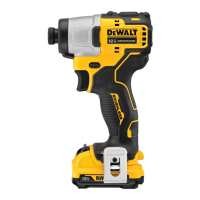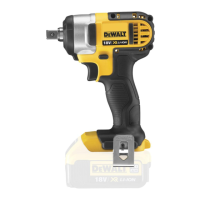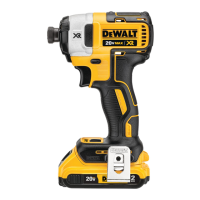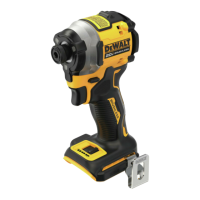10
ENGLISH
WARNING: To reduce the risk of serious personal
injury, turn tool off and disconnect battery pack
before making any adjustments or removing/
installing attachments or accessories. An accidental
start-up can causeinjury.
Proper Hand Position (Fig. D)
WARNING: To reduce the risk of serious personal injury,
ALWAYS use proper hand position asshown.
WARNING: To reduce the risk of serious personal
injury, ALWAYS hold securely in anticipation of a
suddenreaction.
Proper hand position requires one hand on the main handle
8
Variable Speed Trigger Switch (Fig.A)
To turn the tool on, squeeze the trigger switch
3
. To turn
the tool off, release the trigger switch. Your tool is equipped
with a brake. The chuck will stop when the trigger switch is
fullyreleased.
The variable speed switch enables you to start the application at
a slow speed. The further you squeeze the trigger, the faster the
tool will operate. For maximum tool life, use variable speed only
for starting holes orfasteners.
NOTE: Continuous use in variable speed range is not
recommended. It may damage the switch and should
beavoided.
Forward/Reverse Control Button (Fig.A)
A forward/reverse control button
4
determines the direction of
the tool and also serves as a lock-offbutton.
To select forward rotation, release the trigger switch and
depress the forward/reverse control button on the right side of
thetool.
To select reverse, depress the forward/reverse control button on
the left side of the tool. The centre position of the control button
locks the tool in the off position. When changing the position of
the control button, be sure the trigger isreleased.
NOTE: The first time the tool is run after changing the direction
of rotation, you may hear a click on start up. This is normal and
does not indicate aproblem.
Worklights (Fig.E)
There are three worklights
7
located around the 6.35 mm hex
chuck
6
or anvil
10
. The worklights are activated when the
trigger switch isdepressed.
When the trigger is released, the worklight will stay illuminated
for up to 20 seconds. If the trigger switch remains depressed,
the worklights will remainon.
NOTE: The worklights are for lighting the immediate work
surface and are not intended to be used as aflashlight.
Mode Selector (Fig.A)
Your tool is equipped with a mode select button
9
which
allows you to select one of three modes. Select the mode based
on the application and control the speed of the tool using the
variable speed trigger switch
3
.
Precision Drive™ (Fig.A)
DCF801
In addition to normal impacting modes, this tool features the
Precision Drive™ mode which enables greater control in lighter
applications to avoid damage to materials or fasteners. It is ideal
for light applications such as cabinet hinge screws or machine
screws. Precision Drive™ mode will work as a screwdriver in light
applications, before hesitating as the screw head reaches the
work piece, and then (if required) start a slow controlled impact
to ensure the head ends perfectlyflush.
NOTE: This mode is for light duty screwdriving applications.
If the tool will not drive a fastener in Precision Drive™
Mode, please select Lo Mode which will give the additional
powerrequired.
DCF801
Precision Drive™ mode Precision Drive™
Lo Mode Low speed impacting
Hi Mode High Speed Impacting
Precision Wrench™ (Fig. A)
DCF902
In addition to low speed impacting modes, this tool features
the Precision Wrench™ mode which grants the user greater
control in both fastening and loosening applications. When set
in forward, the tool will fasten until impacting begins. The tool
will then pause for 0.5 seconds before continuing to impact,
providing the user with greater control and reducing the chance
of overtightening or damagingmaterial.
When set in reverse, the tool will impact at a normal speed.
Upon sensing that the fastener has broken free, the tool will
cease to impact and will reduce speed to help prevent “run-off”
of loosehardware.
DCF902
Precision Wrench™ Mode Precision Wrench™
Lo Mode Low Speed Impacting
Hi Mode High Speed Impacting
Quick-Release Chuck (Fig.F)
DCF801
WARNING: Use only impact accessories. Non-impact
accessories may break and cause a hazardous condition.
Inspect accessory prior to use to ensure that it con tains
nocracks.
NOTE: The chuck accepts 6.35mm hex bit tips only. Using
25mm bits allows better access in tightspaces.
Place the forward/reverse button
4
in the locked off (centre)
position or remove battery pack before changingaccessories.
To install an accessory, push accessory to fully insert into
chuck
6
. The chuck collar
5
does not need to be pulled up to
lock accessory inplace.
To remove an accessory, pull the chuck collar away from the
front of the tool. Remove the accessory and release thecollar.

